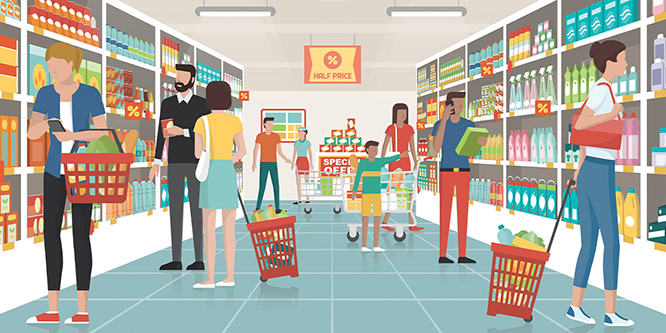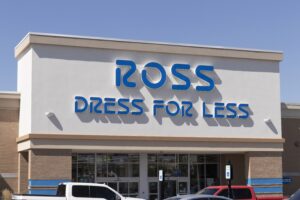
Illustration / WSU
March 14, 2023
Do retailers need a more data-driven approach to in-store merchandising?
New university research finds retailers can use shoppers’ familiarity with a store’s layout to bring a more data-driven approach to in-store merchandising similar to online merchandising.
The researchers developed a product allocation model that uses data mining techniques to extract profitability and product affinity details from tens of thousands of genuine customer transactions contained in Microsoft’s Foodmart database. The model then used a three-step process to determine ideal product placement for stores that periodically rearrange their items:
- Identify a store’s most profitable products to be placed in highly visible locations.
- Determine which items tend to be purchased together so they can be placed in a way that customers will notice something interesting next to a planned purchase.
- Employ “past-aisle impulse” to take advantage of customers’ familiarity with where products used to be to determine future store layouts.
“This last step is designed so that people looking in a familiar place for, say, potato chips will notice something new that our data tells us will interest them,” said Gihan Edirisinghe, the study’s lead author and a Western Kentucky University professor, in a press release. “Every rearrangement can then be used as the basis for the next. To the best of our knowledge, no previous research has considered this effect.”
Numerical simulations found the researcher’s model significantly outperformed allocation methods that rely solely on visual rearrangement and other modeling techniques that use data association.
Jeff Sward, founding partner, Merchandising Metrics, and a BrainTrust member, told RetailWire he liked how the research zeroed in on identifying a store’s most profitable products and which items tend to be purchased together. He said, “It’s all about building average basket size or average transaction value as profitably as possible.”
“Our allocation method could ultimately be something that store managers could install and use with a little training,” said Washington State University professor and co-author Chuck Munson. “When you take into consideration the fact that 80 percent of shoppers don’t make a list before visiting a brick-and-mortar retailer, it is easy to see how important something like this could be to maximizing profits and helping physical stores compete with online retailers.”
Discussion Questions
DISCUSSION QUESTIONS: What do you think of the proposed data-driven merchandising model based on shoppers’ familiarity with store layouts? Can in-store merchandising borrow from online practices and correlate data to shopping tendencies?
Poll
BrainTrust
Dave Wendland
Vice President, Strategic RelationsHamacher Resource Group
Andrew Blatherwick
Chairman Emeritus, Relex Solutions
Paula Rosenblum
Co-founder, RSR Research
Recent Discussions







Most of this is not new. There have been solutions available for some time that use analytics to derive the best merchandising layout, making sure that linked purchase items are located close together and that the layout maximizes profitability. The additional element of monitoring the performance after a change has also been possible for some time. The most important part of store merchandising is to get the right layout for each individual store, not company wide or group level. Retailers should always look at any new merchandise layout to make sure that it is adding sales and profitability.
You are exactly right Andrew. I would add understanding the relationship between complementary products and categories is also important. If Target had simply followed the recommendations from my team based on raw data, it would have allocated half the store to diapers and formula.
The challenge in grocery for years was about who gets the credit for the sale. I remember a center store merchandising group wanted to place steak sauce bottles in a refrigerated coffin holding case-ready fresh meats. The meat merchandiser at the chain objected because the bottles would take space away from cuts his department sold. His department’s performance wasn’t evaluated by cross-merchandising lift. It only got credit for meat sales.
George, I am all for attachment sales and they work very well. At the end of the day, the store gets the sale- period. In this day and age, every penny counts.
George, you’ve hit on a huge issue that I’d sort of forgotten about from back in my space planning days — buyers defending their territories at the expense of the customer or, sometimes, the right thing to do for the store. I remember this coming to a head when shrinking sales in the automotive department had their buyers adding cell phone accessories to their assortments. Much to the chagrin of the electronics team. Twenty years ago we identified that we needed a chance in how merchants’ goals were determined. Never happened.
This is great research. The only thing missing is closing the loop by providing actual shopping behavior data at the shelf, you know, during the moment of truth. This can and is being done in Europe, but retailers as well as CPG players—and grocers in particular—are only starting to adopt this approach here in the U.S.
We really need a data-driven approach to merchandising. We have just relied upon the 4 P’s of product, place, price, and promotion. Today, we also need to add the 5th P (People), which is the shopper’s interaction with the store planogram. We can gain that missing insight from video analytics. It’s the technology that gives us the missing link between what we gather online and what is missing throughout the customer journey.
You mean they don’t do that already? Of course they do–at least partly.
My friend Greg Buzek over at IHL pointed out a long time ago that the implementation of self-checkout (which he is a fan of) did diminish the amount of impulse buys at the register, because shoppers were more focused on which machine would open up first. And the impulse products are always, and have always been, higher margin products.
In fact, I also thought that grocery’s perimeter product was always for the highest margin items and the center aisles were more for staples and canned goods. The urban myth of “diapers and beer” has been around for well over 20 years. I assume that we’re talking more about “data driven on steroids” using much better analytics.
Still, I’m just a little confused.
I think a more significant deterrent for incremental sales is curbside and BOPIS. Personally, not walking through the store for my weekly shopping has cut my weekly grocery bill by about one-third. I don’t see new products, and I’m not tempted by in-store merchandising. Good for my budget, but not as good for sales growth.
I’ve been preaching for quite some time that traditional merchandising and category management needs reinvention. Perhaps this is one of the answers.
Building a basket based on a shopper’s intent and familiarity with a store’s layout is absolutely a path worth considering. With the assistance of tools and data like those described in this research, it will serve to place items more appropriately and inspire consumer purchase behavior.
In fact, I wouldn’t limit this to brick-and-mortar settings. Rather than a “search” bar on a website that directs shoppers to a specific item or group of similar items, why not offer consumers the opportunity to be inspired by asking the question, “What occasion are you shopping for today?” This will drive basket growth, increase loyalty, and eliminate frustration of shoppers who find they missed placing a needed item in their basket.
Every retailer should be doing the basics when it comes to analytics, because even the most rudimentary insights typically uncover new ideas that can lead to better decision making. Identifying the most profitable products and paired affinities should be table stakes. Though these are descriptive in nature, they offer the retailer incredible intelligence for the 20 percent of products that drive 80 percent of the revenues/profits. Moving up the maturity curve to understand what retailers could do and should do (predictive and prescriptive) is how and where retailers can get ahead of the consumer with true data-driven offers and layouts.
A great idea that has been around for a million years — and doesn’t get implemented because of all the holes that pop up. How do you merchandise milk and cookies together? Vegetables and meats? Don’t you think there’s a reason why peanut butter and jelly are not put side-by-side in the store? I’m all for research showing that a new layout is better than the old one – I’ve been doing this research for 30 years. Data driven is not the answer – all you get is a diluted/average answer that is inoperative.
Brilliant Stephen, you put this so much better than I did. About 600 BC the biblical prophet Jerimiah said that no one understands the human heart. Still true today.
My first thought in reading today’s discussion was my mother’s shopping list in the ’50s. She could write her shopping list in the order that she walked the store. I don’t know if that was common then. Supermarkets were simpler back then.
The merchandising model discussed today strikes me as very creative. And it could be valuable as well. The challenge I see is the conglomerated cohort of shoppers. Dealing with averages often leads conclusions astray. What is an excellent placement for one shopper may be confusing for the next.
The one sentence that bothers me is, “Every rearrangement can then be used as the basis for the next.” How often will the product be rearranged?
Retailers have been using data driven merchandising for a long time so this sounds like a new way of interpreting the existing data, nothing else. I believe in data-driven models and this model appears to lead to higher average order values so absent seeing the actual model, it seems reasonable. However I shop at my stores because I know where everything is so please don’t mess with that too much. It’s infuriating and it makes me walk out and order online. And that’s really the point. No data model or store layout will ever compete with the ability of the digital world to render personalized content to each individual shopper during their shopping journey. Fortunately for physical retailers, that’s not where this battle will be won as proven by the fact that e-commerce never became the brick-and-mortar slayer it was once hyped to be.
I think we’re talking grocery stores here, and one thing we know for sure is that people lose their minds when their grocery store does a remodel.
Most retailers already rely on steps 1 and 2. They have identified and honed the merchandising in the most visible locations on the sales floor, and are using those areas to house highly profitable products.
Step 2 is cross-merchandising. I agree with Jeff that it’s all about building basket size and growing transactions. Cross-merchandising, along with strategically placed merchandise outposts, do the trick here.
Step 3 is where you can tell this isn’t a retailer-based study. In the example I would move the potato chips to a new location but merchandise the old space with something else the consumer might need. OK–I may need cat food, you might need paper towels. Data or not, it’s a crapshoot. My money will always be on the skills of the store planning and merchandising professionals who do this every day.
This is very familiar. Twenty years ago, I led the team at Target that was tasked with analyzing and answering this very issue, we called it the “milk analysis.” Do we put milk at the back and make customers walk through the store to get it, hoping for some incremental sales, or do we put it at the front and make it easy to shop?
We were able to get reasonable results using POS data, store CAD drawings, and planogram data. We were able to do change analysis after resets and remodels and used that data for prototype development.
Today the questions are the same, but new data like human movement analysis and in-store mapping allow for more precision and better validation of how customers interact with the physical layout of the store.
This is an absolutely essential analysis. It is in this area of analytics that stores can find incremental sales growth with the real estate assets they already have. For retailers not opening a ton of new stores, this is critical. Connecting online behaviors with in-store behaviors, that’s going to be really game-changing.
In-store merchandising strategies can borrow from online practices and vice versa. Products that go together should be merchandised together.
Think of styling and creating cross-category outfits in apparel. This also applies to the digital experience. Retailers need to make the shopping experience seamless. Store planning and merchandising, online or offline, should reflect how the customer wants to shop.
How customers shop can only be determined by talking to your customers, spending time on the shop floor. Studying shopping patterns and pain points, why customers are leaving your stores or websites out of frustration and the reasons for abandoning carts will also help create a better shopping experience.
As noted, Amazon has always done this — the “people who buy X also buy Y” idea though that may be more suggestion than documentation. I have wondered why salad dressing is five aisles removed from the salad. That said, though the “affiliated products” concept makes sense, there are limitations. Some are physical and some metaphysical. Collecting all the data possible is still a feeble attempt to understand and manipulate the vastness of the human customer’s mind. Take my remarkable and thrilling discovery that Walmart has an already cooked wild rice combo in a hermetically-sealed bag just sitting there on the shelf. What analysis would predict how happy that made me? And yes, I need to get out more.
I don’t have any real great thoughts on these studies. As a retailer, anything that increases margin dollar and sells, makes me happy. That makes the study valid. But one universal point has to to be mandated and driven home: always move product around. Not to confuse anyone, but to own their eyes. Boredom occurs whey layout is rote in presentations. As a retailer you must create excitement and surprise.
You are right Rich. A principle of gestalt psychology is that everything begins with awareness. Certainly true in retail.
There is already some pretty significant data about product interactions gathered every day by retailers’ price optimization systems. So-called “halo” effects happen when the purchase of one item results in a greater likelihood to purchase another. Think: Oreos and milk.
The opposite, “cannibalization” happens when the purchase of one item reduces the likelihood to purchase another. Think: Coca-Cola and milk.
It’s important to note that these effects often link items located in far-flung departments.
While it may be tempting to move items that interact into physical proximity to boost sales, doing so may come at the expense of critical store operational outcomes. Category Management, a foundational business process that retailers use to organize their stores, along with planograms, the schematics they use to locate products on the shelves, require a degree of continuity to deliver predictable results.
So I’m a skeptic about the premise of moving individual products around frequently to trigger shopper awareness. It may produce halo effects in a lab setting, but I doubt the researchers have considered the operational sacrifices of this practice.
I have to agree with the several comments that refer to “nothing new here”. My comment about building average basket size as profitably as possible could be many decades old. It’s now a question of “how”. It used to be gut and instinct. Now it can be data driven. I think the word that is missing is ‘testing’. How are different combinations and adjancies tested, formalized and scaled? Dr. Needel’s example of meat and vegetables poses a valid example. Can digital signage address that? And Liza Amlani makes a good point about cross merchandising. Or maybe it’s lifestyle merchandising versus classification merchandising. In an old fashioned Macy’s, knits and wovens and bottoms were all their own separate departments, and that required some focused shopping to pull it all together. (The designer departments did a good job of pulling together lifestyle statements.) In a new Target, the apparel businesses are built around multi-category lifestyles. To say they are easily shoppable would be an understatement.
At the end of the day, data-driven merchandising is about marrying and merging data and design. Planning is a straighforward process. And the creative design process can be perfectly happy to do its thing without hearing a bunch of statistics. The hard part is merging the two. The planners can help identify what’s trending up and what’s trending down, but what is being tested so that future assortments are not a result of guessing? And designers always have more good ideas than there is space to accomodate. What are the filters, the criteria, for what products make the final cut? The right combination of instinct and data (testing) will enable much more profitable decisions than either avenue alone.
Fundamentally, a data-driven approach to in-store merchandising is nothing new. In the quest to drive conversion rates, increase sales, and increase profit margins, leveraging a pragmatic and scientific approach to merchandise has been the paradigm shift over the past ten years. A customer-centric and product-centric strategy requires transforming the entire retail merchandising and assortment planning operating model to operationalize against all the valuable insights.
Increasingly, we are seeing retailers determining ways to weave in customer insights and the customer journey elements into merchandising, category management, space, and floor planning to maximize sales and profitability. However, the challenge in leveraging a data-driven approach to merchandising and store operations has on the execution side. Particularly since retailers are challenged to mitigate siloed processes, drive a new collaboration model between the various business areas, and overcome technical debt to focus on innovation and unlocking value for the customers and store associates.
I think these various types of data have been used for a while on the macro level. It is not done frequently enough due to the required analysis, disruptions caused by changes, and labor costs. There are new sensor systems collecting data like never seen before that would be very beneficial as well.
In my opinion, what is lacking is the seamless integration of this type of insight into macro solutions for more streamlined decision-making. There is undoubtedly an opportunity to leverage online learning for in-store merchandising. How it’s done is the tricky part.
Retailers can certainly adopt online practices for in-store merchandising to offer better product assortments to customers. In my opinion, human behavior follows certain patterns. If retailers can specifically target these patterns, the data can be analyzed and used to better serve customers.
Therefore, a data-driven merchandising model is a good strategy. It may not be widely used by retailers at the moment, but such strategies will undoubtedly be used more in the future.